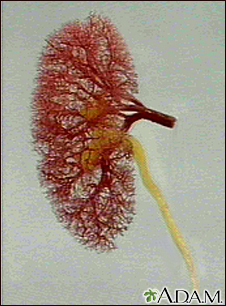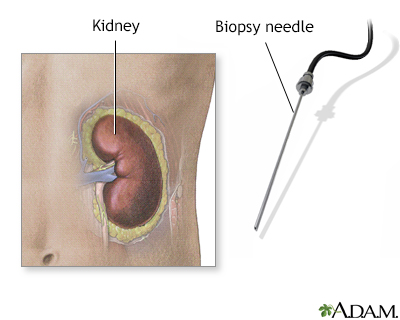Kidney biopsy
Renal biopsy; Biopsy - kidney
A kidney biopsy is the removal of a small piece of kidney tissue for examination.
Images



I Would Like to Learn About:
How the Test is Performed
A kidney biopsy is done in the hospital. The two most common ways to do a kidney biopsy are percutaneous and open. These are described below.
Percutaneous biopsy. Percutaneous means through the skin. Most kidney biopsies are done this way. The procedure is usually done in the following way:
- You may receive medicine to make you drowsy.
- You lie on your stomach. If you have a transplanted kidney, you lie on your back.
- The health care provider marks the spot on the skin where the biopsy needle is inserted.
- The skin is cleaned.
- Numbing medicine (anesthetic) is injected under the skin near the kidney area.
- The provider makes a tiny cut in the skin. Ultrasound images are used to find the proper location. Sometimes another imaging method, such as CT, is used.
- The provider inserts a biopsy needle through the skin to the surface of the kidney. You are asked to take and hold a deep breath as the needle goes into the kidney.
- If the provider is not using ultrasound guidance, you may be asked to take several deep breaths. This allows the provider to know the needle is in place.
- The needle may be inserted more than once if more than one tissue sample is needed.
- The needle is removed. Pressure is applied to the biopsy site to stop any bleeding.
- After the procedure, a bandage is applied to the biopsy site.
Open biopsy. In some cases, your provider may recommend a surgical (open) biopsy. This method is used when a larger piece of tissue is needed or a percutaneous needle biopsy cannot be done safely.
- You receive medicine (anesthesia) that allows you to sleep and be pain-free.
- The surgeon makes a small surgical cut (incision).
- The surgeon locates the part of the kidney from which the biopsy tissue needs to be taken. The tissue is removed.
- The incision is closed with stitches (sutures).
After percutaneous or open biopsy, you will likely stay in the hospital for at least 12 hours. You will receive pain medicines and fluids by mouth or through a vein (IV). Your urine will be checked for heavy bleeding. A small amount of bleeding is normal after a biopsy.
Follow instructions about caring for yourself after the biopsy. This may include not lifting anything heavier than 10 pounds (4.5 kilograms) for 2 weeks after the biopsy.
How to Prepare for the Test
Tell your provider:
- About medicines you are taking, including vitamins and supplements, herbal remedies, and over-the-counter medicines
- If you have any allergies
- If you have bleeding problems or if you take blood-thinning medicines such as warfarin (Coumadin), clopidogrel (Plavix), dipyridamole (Persantine), fondaparinux (Arixtra), apixaban (Eliquis), dabigatran (Pradaxa), or aspirin
- If you are or think you might be pregnant
How the Test will Feel
Numbing medicine is used, so the pain during the procedure is often slight. The numbing medicine may burn or sting when first injected.
After the procedure, the area may feel tender or sore for a few days.
You may see bright, red blood in your urine during the first 24 hours after the test. If the bleeding lasts longer, tell your provider.
Why the Test is Performed
Your provider may order a kidney biopsy if you have:
- An unexplained drop in kidney function
- Blood in the urine that does not go away
- Protein in the urine found during a urine test
- A transplanted kidney, which needs to be monitored using a biopsy
Normal Results
A normal result is when the kidney tissue shows normal structure.
What Abnormal Results Mean
An abnormal result means there are changes in the kidney tissue. This may be due to:
- Infection
- Poor blood flow through the kidney
- Connective tissue diseases such as systemic lupus erythematosus
- Other diseases that may be affecting the kidney, such as diabetes
- Kidney transplant rejection, if you had a transplant
Risks
Risks include:
- Bleeding from the kidney (in rare cases, may require a blood transfusion)
- Bleeding into the muscle, which might cause soreness
- Infection (small risk)
Related Information
Urine - bloodyUrine protein dipstick test
Systemic lupus erythematosus
Transplant rejection
Acute nephritic syndrome
Acute tubular necrosis
Alport syndrome
Atheroembolic renal disease
Diabetes and kidney disease
Focal segmental glomerulosclerosis
Anti-glomerular basement membrane disease
IgA nephropathy
Interstitial nephritis
Lupus nephritis
Autosomal dominant tubulointerstitial kidney disease
Membranoproliferative glomerulonephritis
Membranous nephropathy
Minimal change disease
Nephrotic syndrome
Poststreptococcal glomerulonephritis (GN)
References
Salama AD, Cook HT. The renal biopsy. In: Yu ASL, Chertow GM, Luyckx VA, Marsden PA, Karl S, Philip AM, Taal MW, eds. Brenner and Rector's The Kidney. 11th ed. Philadelphia, PA: Elsevier; 2020:chap 26.
Topham PS, MacGinley. Kidney biopsy. In: Johnson RJ, Floege J, Tonelli M, eds. Comprehensive Clinical Nephrology. 7th ed. Philadelphia, PA: Elsevier; 2024:chap 7.
BACK TO TOPReview Date: 8/28/2023
Reviewed By: Walead Latif, MD, Nephrologist and Clinical Associate Professor, Rutgers Medical School, Newark, NJ. Review provided by VeriMed Healthcare Network. Also reviewed by David C. Dugdale, MD, Medical Director, Brenda Conaway, Editorial Director, and the A.D.A.M. Editorial team.

Health Content Provider
06/01/2025
|
A.D.A.M., Inc. is accredited by URAC, for Health Content Provider (www.urac.org). URAC's accreditation program is an independent audit to verify that A.D.A.M. follows rigorous standards of quality and accountability. A.D.A.M. is among the first to achieve this important distinction for online health information and services. Learn more about A.D.A.M.'s editorial policy, editorial process and privacy policy. A.D.A.M. is also a founding member of Hi-Ethics. This site complied with the HONcode standard for trustworthy health information from 1995 to 2022, after which HON (Health On the Net, a not-for-profit organization that promoted transparent and reliable health information online) was discontinued. |
The information provided herein should not be used during any medical emergency or for the diagnosis or treatment of any medical condition. A licensed medical professional should be consulted for diagnosis and treatment of any and all medical conditions. Links to other sites are provided for information only -- they do not constitute endorsements of those other sites. © 1997- 2025 A.D.A.M., a business unit of Ebix, Inc. Any duplication or distribution of the information contained herein is strictly prohibited.
